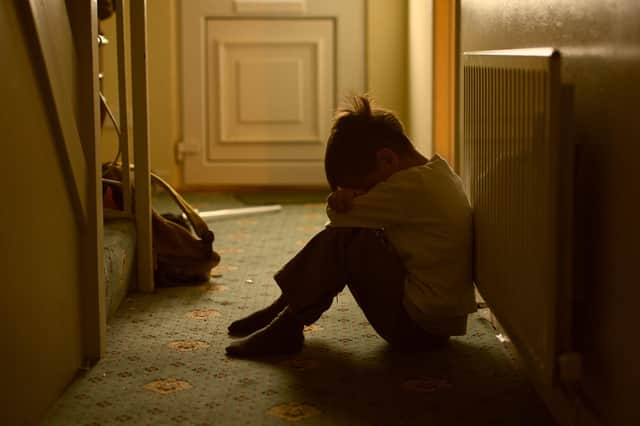Child abuse in Scotland: Backlash against investigations means victims are still going undetected – Dr Sarah Nelson


Indeed, as a proportion of concerns raised through the child protection system, identification has dropped like a stone since the 1990s. A national review of the reasons is urgently needed.
Concern at this trend was such that in 2013, leading Scottish specialists and professionals working with child sexual abuse (CSA) met the Association of Directors of Social Work (now Social Work Scotland) about their deep concern that “sexual abuse is being allowed to disappear off the statutory radar”, overshadowed by priority for other maltreatment, such as neglect and emotional abuse. Different types of abuse, they said, “should not be in competition for resources, but approached on the basis of need”.
Advertisement
Hide AdAdvertisement
Hide AdThere is little sign this has changed. Sexual abuse as a proportion of concerns to the child protection register and child protection case conferences has reduced to below five per cent, with fewer than 300 children across Scotland annually identified in this way.
Yet even with the most conservative estimate of CSA of one in 20 children if, for example, we added together the under-16 populations of Dundee and Aberdeen, more than 3,000 children from those cities alone would have suffered, or be suffering, CSA. Prevalence of one in ten would double that figure.
Of course, the register and case conferences are not the only identifiers, and sexual crimes recorded by police, including crimes against children, continue to rise. But they are at the centre of the official system, and must surely be seen to operate effectively and credibly.
What are some reasons for current failures?
A backlash against investigations into child sexual abuse decades ago has created a watch-my-back culture, where adults fear asking children if they suspect, in case they are accused of leading questions. So they wait for children to disclose – the main finding of a recent Welsh study. Yet most children do not disclose, and it is pointless waiting for them to do so. A disconnect in joint action against CSA and child sexual exploitation (CSE). Belated, welcome action exists against CSE, seen as happening outside the family. CSA is seen as happening largely within it. Yet there is little understanding that older children most vulnerable to CSE and online grooming have already been victims of CSA when younger, and were not protected. Many perpetrators abuse within and beyond their families, grooming or exchanging their children for sexual exploitation and production of abuse images. The increasing tendency to concentrate child protection on the under-fives and even pre-birth, with its mother-blaming, militates against detection of sexual abuse in the over-fives, where the majority of CSA, mostly by males, happens. Trauma training, including sexual abuse identification, remains inadequate for the professionals whom children are supposed to tell. Such training of social workers was left until postgraduate level in the course I taught, while training of children's panel members on CSA is minimal: yet how many troubled young people, with acting-out behaviour after sexual abuse, regularly come before these panels? If disclosures happen they have often led to authorities rushing in, sufficient evidence is usually unavailable, and return to their abuser one cruel result. Many young survivors say they waited until the age of 16 to tell because they were afraid of control being taken from their hands. What sort of protection system produces that?
Change required
A national review in Scotland is needed into reasons for the decline in identification through the child protection system, where concerns about "emotional abuse" and "neglect" have mushroomed. Are these real increases and decreases, or changes in fashion and training?
The review needs to include samples of case files, following a recent Welsh example where suspicions of sexual abuse were found in far more files than ever reached a conference or register – yet they were dispersed, data was hard to use, or not followed up.
Specialist police-and-social-work teams, which did excellent work against CSA and identified many perpetrators in the 1980s and 1990s before being dismantled, need re-establishing. Some excellent joint work exists in Scotland against CSE now.
Considerably greater resources, to investigate the massive growth in online abuse images and identify child victims, are needed.
Advertisement
Hide AdAdvertisement
Hide AdDetailed training, support and confidence-building about CSA, its signs and common impacts on young people’s behaviour are needed for the people children are supposed to tell, including social workers, teachers, youth workers and children’s panels. Support systems and referral pathways are needed for mothers and children's friends, who are overwhelmingly the people they do tell.
Assertive, not timid approaches to countering CSA are needed, including directly asking children gently if staff suspect – as they would if they saw bruises. Survivors of all ages say repeatedly how they wanted that. Do not hand-wring about what a supposedly “difficult and complex” area this is: ask them.
All sexual health clinics need more awareness of coercion, should ask gentle questions and express their worries to young people. Sexual abuse leaves sexual signs, like very young pregnancy.
If there are disclosures, slow down the investigative process instead of any "big boots" approach involving frightened young people – give them time to sort their fears so they are less likely to retract. Develop imaginative means of enabling children to tell, and connect them into third-sector organisations when there are suspicions, should they need to tell in their own time. Projects called "Time to Listen" were recently trialled in three Scottish authorities with this idea, but have now ended through time-limited funding.
The new Bauhaus model of Children’s Houses, originating in Scandinavia and being introduced in Scotland, is very positive, though mainly for the children already identified as sexually abused. However, could they in future become one important hub for widening professional awareness and confidence among abused young people?
Dr Sarah Nelson is a research associate at CRFR, Edinburgh University and was recently awarded an OBE for work with survivors of sexual abuse